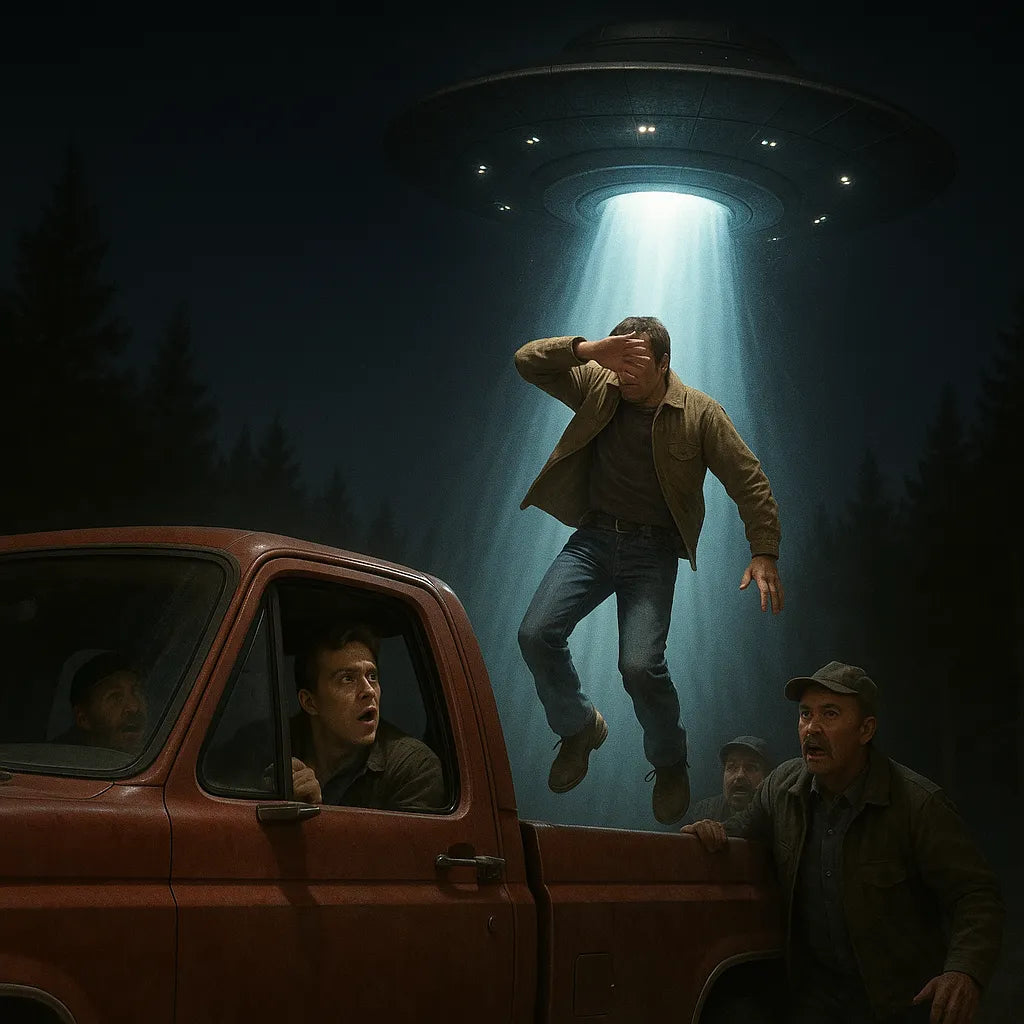
The Travis Walton Abduction: Five Missing Days in Arizona’s Forests
Share
The Travis Walton Abduction: Five Missing Days in Arizona’s Forests
On the night of November 5, 1975, seven tired loggers bounced along a dirt road in Arizona’s Apache–Sitgreaves National Forest, heading home after a long day’s work. Only six of them made it back that night.
According to their story, 22-year-old Travis Walton stepped out of their truck to get a better look at a glowing disc in a clearing. A sudden blue-green beam of light shot down, lifted him off the ground, and slammed him backward. His crew, thinking their friend had just been fried alive by something out of Close Encounters, floored the gas pedal and fled.
When they worked up the courage to return a few minutes later, Walton was gone.
A Vanishing Act That Made Headlines
At first, police weren’t buying the alien story. Deputy Chuck Ellison later admitted he thought it might be a cover-up for something much darker — maybe a fight gone wrong out in the woods. A homicide investigation was even on the table.
But the massive search that followed only deepened the mystery. Dozens of volunteers, deputies, forest rangers, even helicopters scoured the site. No blood, no footprints, no body. Just silence and six panicked loggers who refused to change their story.
By morning, the strange case was splashed across headlines. Snowflake, Arizona — a quiet town nobody outside Navajo County had ever heard of — suddenly had news vans parked on Main Street.
The Return: Five Days Later
Five days later, sometime after midnight on November 11, the phone rang at Walton’s sister’s house. It was Travis, calling collect from a payphone in nearby Heber.
Family found him crumpled in the booth, gaunt, pale, and weak. He was dehydrated, dazed, and convinced only a few hours had passed. “They’re horrible,” he reportedly whispered before collapsing into his brother’s arms.
Doctors who examined him were just as baffled. He had lost weight, had a small puncture on his arm, but no bruises or broken bones you’d expect from being blasted backward by an energy beam. Even his blood work raised eyebrows — the chemistry didn’t match a man who had gone without food for five days.
Inside the UFO (According to Walton)
Walton’s memory came in flashes. He recalled waking up on a table under harsh lights, pain radiating through his chest. Around him stood three small, pale humanoids with oversized heads and brown, almond-shaped eyes.
Terrified, he lashed out, knocking one aside, and stumbled into another chamber. There he met a man in a helmet and jumpsuit — human-looking but eerily off, with golden, oversized eyes.
That figure led him into a room with three tall, human-like beings — two men and a woman with long blond hair. They didn’t speak. They simply smiled, placed a mask over his face, and that was the last thing he remembered until waking on the roadside in Heber, staring up at the night sky as the UFO drifted silently away.
 Polygraphs and Doubt
Polygraphs and Doubt
To clear the crew of murder suspicions, police ordered polygraph tests. Five of the six passed. Examiners said they truly believed their friend had been taken by something they couldn’t explain.
Walton’s own results? A mixed bag. Some tests said he was truthful. Others branded him deceptive. Decades later, a nationally televised polygraph stunt even called him a liar. Walton brushed it off, claiming TV game-show machines aren’t real science.
The Skeptical Side of the Story
Not everyone bought the abduction tale. Critics offered plenty of earthbound explanations:
-
Contract trouble: The logging crew was behind schedule, and their Forest Service contract carried penalties. A UFO abduction, skeptics argued, was the perfect “act of God” excuse.
-
Pop culture fuel: Weeks earlier, a TV movie about the Betty and Barney Hill abduction aired. Walton and his brother were already fascinated with UFOs. Maybe the story didn’t come from the stars — maybe it came from prime-time television.
-
Medical head-scratchers: Doctors never found the bruises or injuries you’d expect from a man supposedly thrown ten feet by an alien death ray.
-
Suspicious behavior: The first call Walton’s brother made after his return wasn’t to the sheriff — it was to a UFO research group. Skeptics still point to that as a red flag.
And yet, through decades of scrutiny, none of the seven men involved have ever recanted. That consistency alone keeps believers convinced.
 From Missing Logger to Hollywood
From Missing Logger to Hollywood
Walton’s story didn’t fade. He published a memoir, The Walton Experience, and in 1993 Paramount turned it into the movie Fire in the Sky — a nightmare-fueling dramatization that gave an entire generation fresh abduction nightmares.
Even today, the Heber payphone where he reappeared is decorated with alien art and listed in travel guides as one of America’s strangest roadside attractions. Walton himself still appears at UFO conventions, telling his story to packed auditoriums.
Conclusion: Believers, Skeptics, and a Legend
Nearly fifty years later, the Travis Walton case still sits in a gray zone between folklore and fact. To believers, it’s one of the strongest alien abduction stories ever told — backed by multiple witnesses and polygraphs. To skeptics, it’s a clever hoax born out of contract stress, 1970s UFO mania, and a flair for storytelling.
What’s undeniable is its cultural footprint. Travis Walton’s five missing days are still talked about, still filmed, still dissected. Whether you see it as proof of aliens or proof of human imagination, the story refuses to vanish — just like Walton himself did in that Arizona forest.


